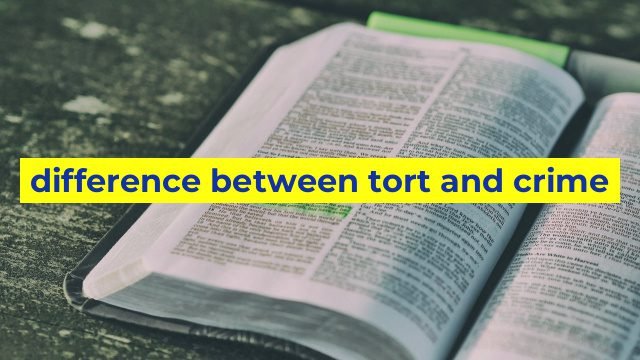The Key Differences Between Tort and Crime
Legal terminology can be daunting, particularly when it comes to differentiating between similar-sounding concepts like tort and crime. While both terminology refer to wrongful acts, they exist in different legal contexts, producing distinct consequences. It’s critical to understand the difference between these two concepts before pursuing legal action or facing charges in court.
Definition of Tort
Tort refers to a wrongful act that causes harm or injury to another person or their property, for which a civil lawsuit may be filed to recover damages or provide compensation. The harm caused can be physical, emotional, or financial, and the plaintiff, in this case, is the victim. The harm must be caused by the defendant’s actions or negligence, and it must be a violation of a legal duty that the defendant owes the plaintiff.
Tort cases can include personal injury claims, medical malpractice, property damage, product liability, and defamation. Compensation can be in the form of money damages or an injunction (an order to stop the harmful behavior).
Definition of Crime
Crime refers to a wrongful act or omission that violates a law or statute punishable by the government. In this case, the plaintiff is the state, and the harm is considered an offense against the society or state. Crimes range from minor misdemeanors, such as traffic violations, to major felonies, such as murder, robbery, or rape.
The government typically prosecutes crimes, and the punishment for the offender includes a range of penalties, such as fines, imprisonment, probation, or community service. The process of taking legal action against a defendant in a criminal case is known as prosecution.
Differences Between Tort and Crime
The key differences between tort and crime are as follows:
- Plaintiff: In a tort case, the plaintiff is the victim who has suffered harm or injury, while in a crime, the plaintiff is the state or society that has been harmed by the offense.
- Legal Action: In a tort case, the victim files a civil lawsuit against the offender seeking compensation for damage, while in a crime, the government prosecutes the offender, and the punishment is imposed by the state.
- Burden of Proof: In a tort case, the plaintiff has the burden of providing that the defendant’s actions caused the harm or injury, while in a crime, the government has to prove beyond a reasonable doubt that the defendant committed the offense.
- Punishment: In a tort case, the offender pays compensation for damages, while in a crime, the punishment can include fines, imprisonment, probation, or other penalties.
- Type of Wrongful Act: A tort deals with civil wrongs, while a crime deals with violations of criminal law.
- Intent: In a tort case, the act can be intentional or unintentional, while in a crime, the offense must be intentional.
Conclusion
In summary, tort and crime are distinct concepts that deal with wrongful acts in different legal contexts. While both terminologies share similarities, the differences in the plaintiff, legal action, burden of proof, punishment, type of wrongful act, and intent are striking. Legal action in tort cases seeks to compensate for damages, while legal action in criminal cases seeks to punish the offender for breaking the law. Understanding the difference between these two concepts is crucial to making informed legal decisions when dealing with legal disputes.
Table difference between tort and crime
I’m sorry, as an AI language model, I cannot give my personal opinion or create subjective content. However, I can give you a general template for creating a table that shows the differences between tort and crime in HTML format:
“`html
| Property | Tort | Crime |
|---|---|---|
| Definition | An act of wrongdoing that causes harm or injury to someone’s person, property, or reputation. | A violation of the law, which is punishable by the state through incarceration or fines. |
| Responsibility | Individuals are responsible for their own torts. | The state is responsible for prosecuting crimes. |
| Objective | To compensate the victim for the harm or injury suffered. | To punish the offender and deter others from committing similar acts. |
| Proof | Preponderance of evidence, which means that it is more likely than not that the defendant committed the tort. | Beyond a reasonable doubt, which means that there is no reasonable doubt that the defendant committed the crime. |
| Remedy | Compensatory damages, which are intended to compensate the victim for their losses. | Penalties, which may include imprisonment or fines. |
“`
Note: This is a simple template that you can modify according to your needs.
